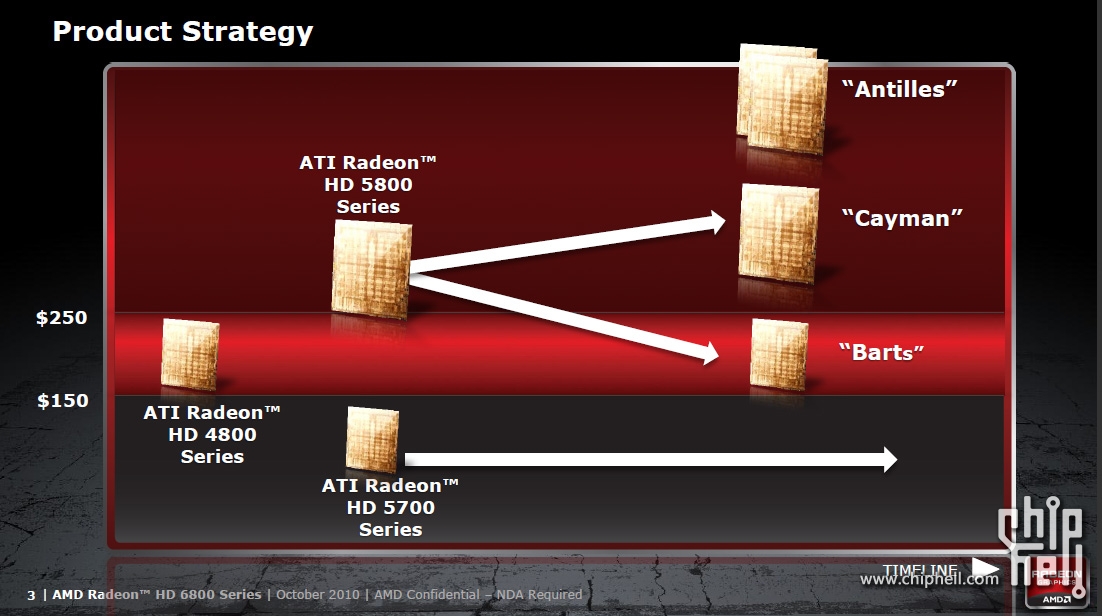Alright, this came to me while I was super ripped last night  cool
cool but it makes SO MUCH SENSE.
but it makes SO MUCH SENSE.
I know everyone's been griping about AMD changing their naming scheme this generation, renaming the formerly 67X0 to the 68X0, and how such a change makes "no sense", "hurts consumers", etc. But I think I understand their reasoning.
First, we have to get some requisite facts out of the way:
1. ~20" monitors are the norm. As fantastic as 30" 2640x1600 (or whatever they are) screens and Eyefinity setups are, they are still a very niche market. Most of the gaming community is still using 1920x1200 or lower.
2. The 5870 plays all, or almost all, new games at more than sufficient framerates at those resolutions.
Alright, so what does this have to do with the naming scheme change? Well, think about those points for a second. I know it may bring some arguments, but the fact is, for a normal gamer at this point in time, there is no need for more performance than what the 5870 provides. Yes, the 480GX is faster, but really, unless you're maxing out your system (which, again back to point 1, I know most gamers aren't), the extra performance it gives is negligible.
Seeing this AMD's marketing came to a logical conclusion: There is no need to increase performance this generation. I'm sure that made you go "Huh!?", but if you think about it, when, at 6XXX release, the 5XXX series is still very relevant, what point is there to just further increase performance, especially since (point 2) most and if not all games do not require a massive performance boost?
As a result, AMD chose to use this generation, not to make a faster chip, but to make a more efficient chip. The 68X0 still IS the high end; it's just that the high end performance hasn't changed! What we have instead is the same performance, from fewer units, less power, and less heat. We get that every generation, but we usually get a performance boost as well. AMD just thought we didn't need that this gen, and that performance boost is what the ultra-high-end 69X0 series is for.
The main reason, though, is for future proofing. This gave AMD a chance to flesh out these new Cayman chips while making the high-mid end cards (68XX) more efficient and cheaper. I'm sure in the coming months we will see an actual 67XX card, simmilar to the 57XX's but much cheaper than them. If they do this across the whole low to high-mid market, I can see exactly why it makes sense.
Thinking about it this way, I see no problem with AMD's strategy, and in fact it kinda makes sense. Perhaps it doesn't to anyone else, but I thought I'd throw it out there!
Disclaimer: I apologize if I'm talking out of my ass and have no idea what I'm talking about. It all makes sense to me, at 11am, on a Monday morning though

I know everyone's been griping about AMD changing their naming scheme this generation, renaming the formerly 67X0 to the 68X0, and how such a change makes "no sense", "hurts consumers", etc. But I think I understand their reasoning.
First, we have to get some requisite facts out of the way:
1. ~20" monitors are the norm. As fantastic as 30" 2640x1600 (or whatever they are) screens and Eyefinity setups are, they are still a very niche market. Most of the gaming community is still using 1920x1200 or lower.
2. The 5870 plays all, or almost all, new games at more than sufficient framerates at those resolutions.
Alright, so what does this have to do with the naming scheme change? Well, think about those points for a second. I know it may bring some arguments, but the fact is, for a normal gamer at this point in time, there is no need for more performance than what the 5870 provides. Yes, the 480GX is faster, but really, unless you're maxing out your system (which, again back to point 1, I know most gamers aren't), the extra performance it gives is negligible.
Seeing this AMD's marketing came to a logical conclusion: There is no need to increase performance this generation. I'm sure that made you go "Huh!?", but if you think about it, when, at 6XXX release, the 5XXX series is still very relevant, what point is there to just further increase performance, especially since (point 2) most and if not all games do not require a massive performance boost?
As a result, AMD chose to use this generation, not to make a faster chip, but to make a more efficient chip. The 68X0 still IS the high end; it's just that the high end performance hasn't changed! What we have instead is the same performance, from fewer units, less power, and less heat. We get that every generation, but we usually get a performance boost as well. AMD just thought we didn't need that this gen, and that performance boost is what the ultra-high-end 69X0 series is for.
The main reason, though, is for future proofing. This gave AMD a chance to flesh out these new Cayman chips while making the high-mid end cards (68XX) more efficient and cheaper. I'm sure in the coming months we will see an actual 67XX card, simmilar to the 57XX's but much cheaper than them. If they do this across the whole low to high-mid market, I can see exactly why it makes sense.
Thinking about it this way, I see no problem with AMD's strategy, and in fact it kinda makes sense. Perhaps it doesn't to anyone else, but I thought I'd throw it out there!
Disclaimer: I apologize if I'm talking out of my ass and have no idea what I'm talking about. It all makes sense to me, at 11am, on a Monday morning though
![[H]ard|Forum](/styles/hardforum/xenforo/logo_dark.png)
